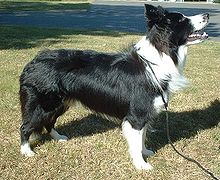Border Collie
 |
|||||||||||||||||||||||||||||||||
| Other names | Scottish Sheepdog (sometimes confused with the related Welsh Sheepdog) |
||||||||||||||||||||||||||||||||
|---|---|---|---|---|---|---|---|---|---|---|---|---|---|---|---|---|---|---|---|---|---|---|---|---|---|---|---|---|---|---|---|---|---|
| Origin | United Kingdom English-Scottish border. |
||||||||||||||||||||||||||||||||
|
|||||||||||||||||||||||||||||||||
|
|||||||||||||||||||||||||||||||||
| Domestic dog (Canis lupus familiaris) | |||||||||||||||||||||||||||||||||
| Traits | |||
|---|---|---|---|
| Weight | Male | 14–20 kg (31–44 lb) | |
| Female | 12–19 kg (26–42 lb) | ||
| Height | Male | 48–56 cm (19–22 in) | |
| Female | 46–53 cm (18–21 in) | ||
| Coat | smooth or rough double coat | ||
| Colour | solid coloured, bicoloured or tricoloured on blue merle, red merle, chocolate merle, liver, lilac merle, chocolate, lilac, blue, sable merle, sable, shaded sable, chocolate sable, black, white, red, or brindle. | ||
| Litter size | max. 10 | ||
| Life span | 10-14 years, average of 12 years | ||
| Classification / standards | |||
|---|---|---|---|
| FCI | Group 1, Section 1 Sheepdogs #297 | standard | |
| AKC | Herding | standard | |
| ANKC | Group 5 (Working Dogs) | standard | |
| CKC | Group 7 (Herding) | standard | |
| KC (UK) | Pastoral | standard | |
| NZKC | Working | standard | |
| UKC | Herding Dog | standard | |
The Border Collie is a working and herding dog breed developed in the Anglo-Scottish border region for herding , especially sheep. It was specifically bred for intelligence and obedience.
Considered highly intelligent, extremely energetic, acrobatic and athletic, they frequently compete with great success in sheepdog trials and dog sports. They are often cited as the most intelligent of all domestic dogs. Border Collies continue to be employed in their traditional work of herding livestock throughout the world.
In general, Border Collies are medium-sized dogs with a moderate amount of coat, which is most often thick and sheds often. They have a double coat which varies from smooth to rough, and is occasionally curled. Whilst black and white is most commonly seen colour pattern of the Border Collie, the breed appears in just about any colour and pattern known to occur in dogs. Some of these include black tricolour (black/tan/white), liver and white, and red tricolour (red/tan/white) have also been seen regularly, with other colours such as blue, lilac, red merle, blue merle, brindle, and Australian red (also known as ee red, blonde, recessive red, or gold) which is seen less frequently. Some Border Collies may also have single-colour coats.
Eye colour varies from brown to blue, and occasionally eyes of differing colour occur; this is usually seen with merles. The ears of the Border Collie are also variable — some have fully erect ears, some fully dropped ears, and others semi-erect ears (similar to those of the rough Collie). Although working Border Collie handlers sometimes have superstitions about the appearance of their dogs (handlers may avoid mostly white dogs due to the unfounded idea that sheep will not respect a white or almost all white dog), in general a dog's appearance is considered by the American Border Collie Association to be irrelevant. It is considered much more useful to identify a working Border Collie by its attitude and ability than by its looks.
...
Wikipedia
